They’re everywhere — these little rice cakes with cane sugar drizzle: on the streets, in the supermarket, in snack stores from the upscale ones to the not-so-upscale ones. The only explanation for this is that people like them. A lot. And it’s not difficult to see why.
With these sweet rice cakes being so ubiquitous, I’d never learned to make them until I came to the US. Nobody in my family made/make them either. Many street foods — most of them, if you ask me — are best left to the pros. Pad Thai, for example, is not generally a family dish which people make at home. Nang Let (also spelled Nang Led) or Khao Taen (in the Northern dialect) isn’t either, though it’s possible that it might have begun in the Northern (or even Northeastern) region as a way of repurposing old, leftover sticky rice in the pre-microwave days.
But I had to learn how to make these, because they’re not available in the US. Trader Joe’s used to import them from Thailand, but they had dropped this product after a while — at least that’s the case with the stores in my area. This post is brought to you by — that’s right — desperation and deprivation.
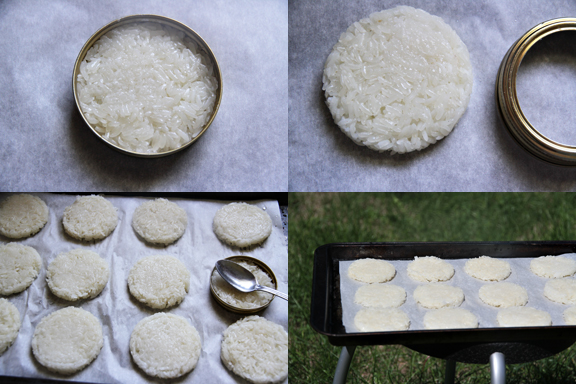
With a moistened spoon, press the rice into an inverted Mason jar ring making sure the edges aren’t jagged, flip the ring over, push the rice out with the back of the spoon, and dehydrate the rice cakes.
Good thing these rice cakes are extremely easy to make. The ingredient list is also very short, as you’ll see.
But to be on a safe side, let me preemptively answer some imaginary questions which I suspect some of you might have.
Q: Can I use jasmine rice in this recipe?
A: No.
Q: But …
A: (Covering her ears) “YANKEE DOODLE WENT TO TOWN A-RIDING ON A PONY, STUCK A FEATHER IN HIS CAP AND CALLED IT …”
Q: Wow. That’s mature of you, Leela. Seriously, though, can I use non-sticky long grain rice?
A: You can. But I wouldn’t. And if pressed, I’d say you shouldn’t. Fried jasmine rice cakes are nowhere near as light and crispy as fried sticky rice cakes. I’ve tried using jasmine rice in this recipe, and I didn’t like the result at all.
Q: Can I use Japanese (Korean, Italian, etc.) short-grain rice?
A: These short-grain rice varieties aren’t used in traditional Thai dishes, including this one. But to be honest, I’ve never tried making these rice cakes using those types of rice. If you’d like to experiment with them, please do. And if you’d like to report back your results, I’d greatly appreciate it.
Q: Just what is Thai sticky rice, anyway?
A: Here you go: What is Thai Sticky Rice?
Q: Gotcha. Now how do you cook it?
A: This is how I cook Thai sticky rice.
Q: The Northern tradition includes watermelon juice in the recipe? How come yours doesn’t? What do you have against watermelons?
A: First of all, let me assure you that I have nothing but utter respect for watermelons and their juice.
And it’s true that many recipes, especially those that follow the Northern Thai tradition, have you either soak the raw rice in watermelon juice or add some watermelon juice to the cooked rice. This, it has been claimed, results in the rice cakes being a bit sweeter and more crispy as well as taking on a nice, brownish/reddish color when fried.
According to my experience, this has proven more of a hassle that doesn’t yield any benefits great enough to justify it. In the end, the main source of sweetness is still the molten cane sugar drizzle, and the subtle sweetness (which people swear they can taste) from the watermelon juice added to the cooked rice does not make any difference to me. The addition of watermelon juice, on the other hand, can present a bit of a problem: 1. the juice tends to dilute the glutinous starch that holds the cooked sticky rice kernels together making it harder for an amateur to form a nice, compact rice disk, and 2. the extra sugar that comes from the watermelon juice makes the rice cakes susceptible to browning too soon (before each kernel has a chance to puff up and become light and crispy) or burning in the fryer.
You weigh the pros and cons and decide. I’ll include instructions for both methods in the recipe below.
Q: How do you get the rice cakes to be the same size and uniform?
A: Glad you asked.
The best tool for this task is a standard Mason jar ring. It’s almost like they had khanom nang led in mind when they designed these metal rings. Measuring 2 3/8 inches in diameter, a Mason jar ring produces rice cakes that aren’t too big or too small. Besides, the hole in the middle allows you to unmold the pressed cooked rice easily with the back of a spoon. Don’t have a Mason jar ring? An empty tuna can with both ends removed would work as well.
Q: Oh, back to the rice thing — can I use the sticky black/purple rice you use to make black/purple rice pudding?
A: Yes, by all means. You’re going to have to be more vigilant when frying the purple rice cakes, though. With the rice being dark in color, the fry-until-light-brown thing doesn’t apply, and it’s hard to know when your rice cakes are ready. If this is your first time making this recipe and you opt for the purple rice, be prepared to sacrifice the first couple of rice cakes for the sake of experimentation.
Nang Let vendor drizzling molten cane sugar, kept warm in a rice cooker, on fried rice cakes (Or Tor Kor Market, Bangkok)
Q: It’s been raining/snowing/cloudy/extremely humid every day where I live. Also, my next door neighbor is a kleptomaniac with a rice cake fetish. I can’t leave out my rice cakes to sun-dry in my backyard for hours!
A: Fear not. You can dehydrate your rice cakes in the oven. Simply form your rice cakes right on a parchment-lined cookie sheet and transfer the sheet to a 120 degrees F oven to dehydrate for 8-10 hours or until there is no moisture left in the cakes. If you have a dehydrator, you can use that as well. Be sure to flip the rice cakes once half-way through.
Q: Can I use commercial rice cakes that you find at the health food store for this?
A: (Staring blankly, silently into space as a single tear rolls slowly down her right cold, numb cheek.)
Q: Enough with the drama — where can I find this type of cane sugar?
A: If you live in Thailand, seek out the product called nam tan oi (น้ำตาลอ้อย). If not, go for panela or the cylindrical piloncillo found at most Hispanic grocery stores. If you still can’t find those, go for jaggery which is often found at South Asian grocery stores.
Q: Can I use palm sugar?
A: You can, but you shouldn’t. Palm sugar is not a traditional choice of sugar for this particular application. Its flavor is not as strong as panela/piloncillo or jaggery. Also, instead of resting on the surface of the rice cakes like the types of semi-processed cane sugar mentioned above (which, if I’m not mistaken, partly consists of inverted sugar), molten palm sugar tends to just disappear into the nooks and crannies of the rice cakes. In terms of appearance, the color of palm sugar is also too light to stand out against the light brown background — not a deal-breaker, but you know …
Q: How do I store the finished product?
A: Simply stack up these rice cakes and store them in an airtight container or a plastic food storage bag. Stored that way, the rice cakes keep well for up to weeks. Be sure to allow the sugar drizzle to harden completely first so they don’t stick together.
Q: Should we get started?
A: Why, yes, indeed.
- 1.5 cups raw Thai sticky rice
- ½ cup watermelon juice, optional
- ½ teaspoon salt
- Bland vegetable oil (don't use peanut or olive oil) for deep-frying
- 6 ounces panela, piloncillo, or jaggery
- ¼ cup water
- Soak and steam the sticky rice until thoroughly cooked. Mix in the salt (and watermelon juice, if used), and allow the rice to cool completely.
- Form the cooked rice into rounds measuring approximately 2¾ inches in diameter and ¼ inch in thickness (see post on what tools to use to achieve uniformity). It's best to do this right on a parchment-line cookie sheet on which you plan to sun-dry or oven-dry your rice cakes, so there's no need to transfer them after they have been formed.
- Sun-dry or oven-dry the rice cakes until they are completely free of moisture (see post).
- Place enough vegetable oil in your deep-frying vessel so that it is at least 3 inches deep. Set the fryer on medium heat.
- Once the oil reaches 300 degrees F, gently lower the rice cakes into it, one by one. Do not crowd the fryer. Flip the rice cakes back and forth until the kernels have puffed up and the rice cakes are light brown and crispy. This should take about a total of one minute. (Adjust the heat as necessary. If the oil is too hot, the rice cakes will brown before they have a chance to crisp up.)
- Once the rice cakes are done, fish them out onto a paper towel-lined cookie sheet. Let them cool.
- While the rice cakes are cooling down, prepare the sugar drizzle by placing the sugar in a small saucepan along with the water. (If you use small piloncillo, there's no need to chop them up, but if you would want to cut a big chunk of panela or jaggery into smaller pieces first.)
- Once the sugar has melted, quickly drizzle it in circular pattern on top of each rice cake. Allow the molten sugar to harden before consuming and storing.







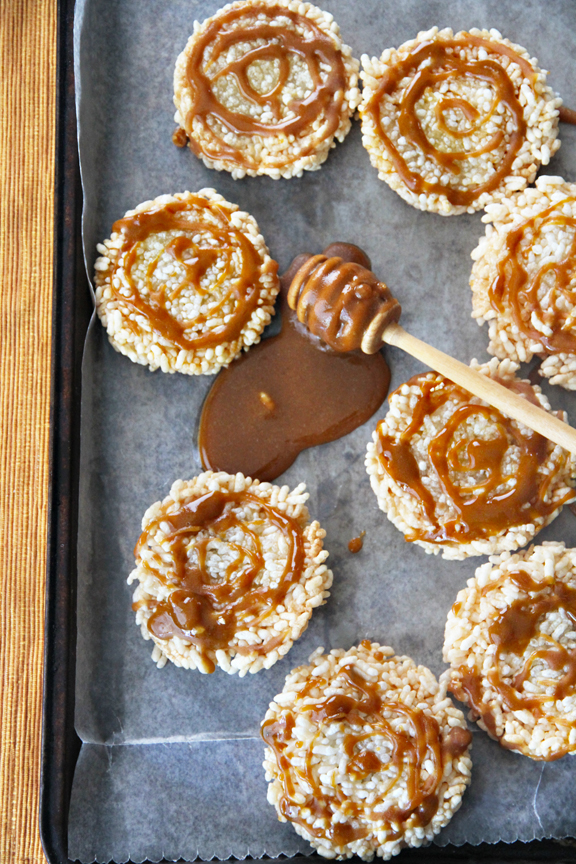
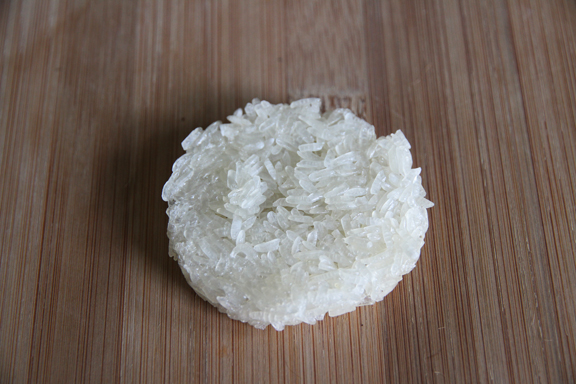
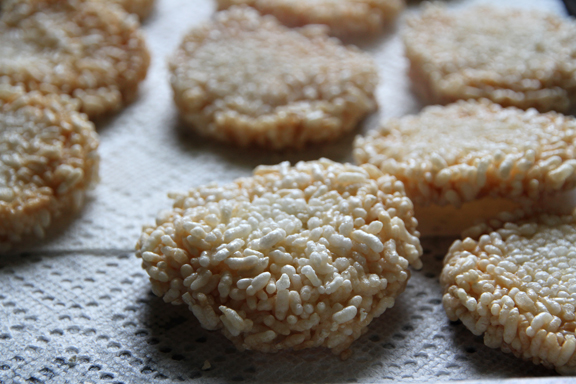
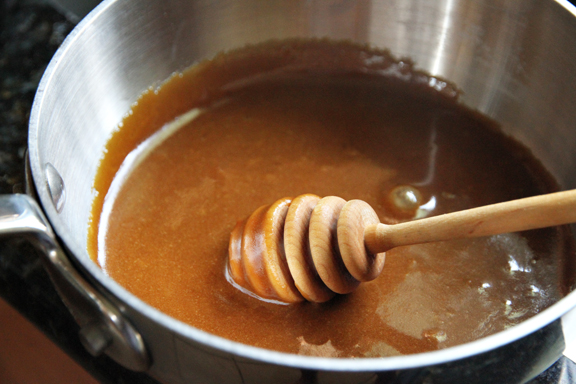
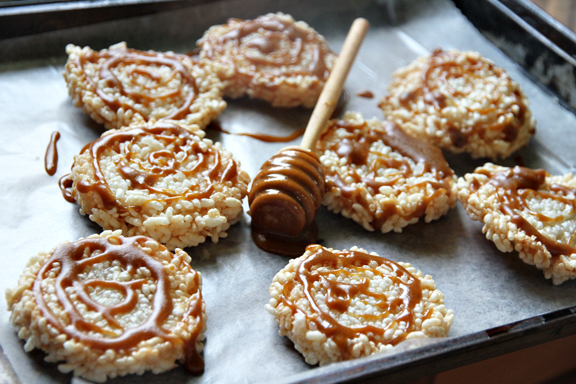

17 Responses to Nang Let, Khao Taen: Thai Sweet Crispy Rice Cakes with Cane Sugar Drizzle (ขนมนางเล็ด ข้าวแต๋น)